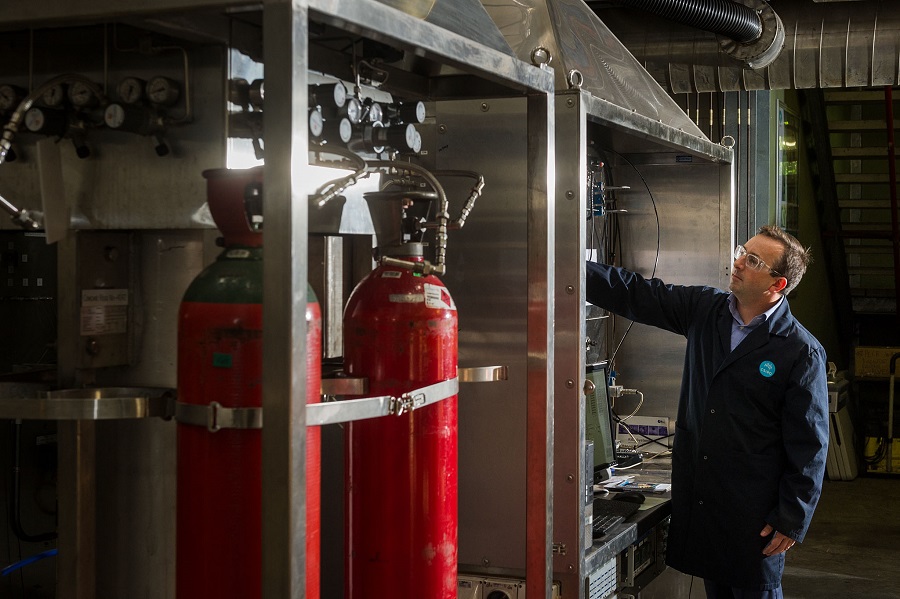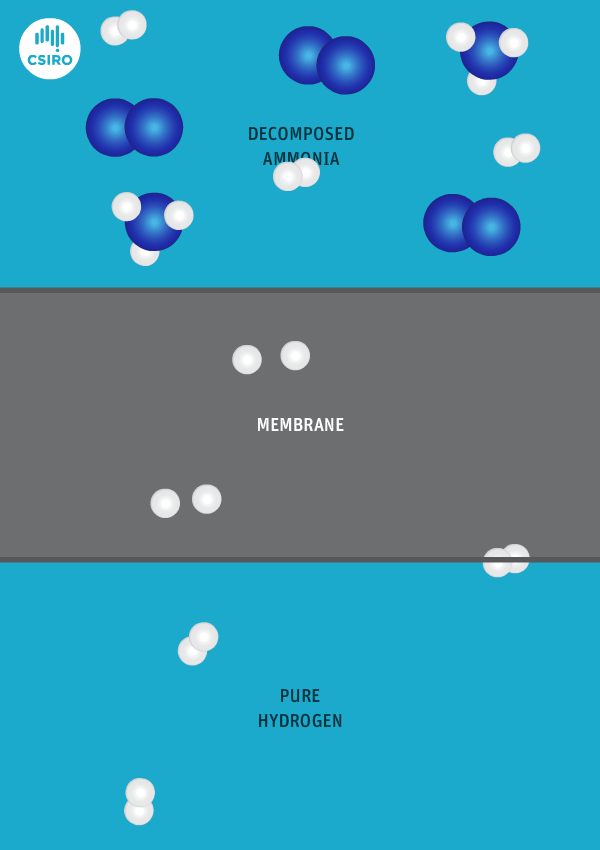We have developed a metal membrane that could accelerate the roll-out hydrogen fuel cell vehicles, and potentially develop a new export market for Australia.

Photo of CSIRO researcher in hydrogen lab.
Dr Michael Dolan in our hydrogen lab.
It’s colourless, odourless, the most abundant element in the universe, and may one day take you from 0-100 on the highway. It seems as though hydrogen is a pretty logical choice for clean fuel of the future. The kicker is that there’s very little pure hydrogen to be found anywhere on Earth, meaning we need to somehow produce it.
There are a couple of different ways to produce pure hydrogen – it can be extracted from natural gas, though carbon dioxide is a by-product. There’s also a renewable option through the electrolysis of water, which produces hydrogen and oxygen. Forcing this reaction requires a fair amount of energy which could potentially come from a clean source, like solar.
Then there’s the matter of transporting that pure hydrogen to the places it’s needed, and if we’re planning a hydrogen-powered vehicle revolution, that means every service station! Because of its low density, hydrogen can be difficult to transport and must be pressurised, and then carried by pipeline, tanker or some other secure method. While hydrogen is already being used around the world, the existing transport infrastructure is not enough to support widespread consumer use. As a standalone hydrogen delivery system, this isn’t shaping up to be cost or energy efficient.
But rest assured there are other options … ammonia for example. Ammonia is a compound of nitrogen and hydrogen that is already transported far and wide for use in industry (as fertiliser, cleaner, etc). What if we could piggyback this existing infrastructure and transport the hydrogen within the ammonia, and then extract the hydrogen from the ammonia at, or near, the point we need it?
We have spent many years researching the best ways to separate pure hydrogen from mixed gas streams, but in this case we’re separating high-purity hydrogen from ammonia. For this very purpose, we’ve developed a thin metal membrane that allows hydrogen to pass, while blocking all other gases.

An animation shows ammonia molecules passing through a membrane to become hydrogen.
Decomposed ammonia passes through our membrane, becoming pure hydrogen.
Our membrane means that hydrogen can be transported in the form of ammonia (which is already being traded globally), and then reconverted back to hydrogen at the point of use.
While Australia is a relatively small hydrogen market, the fuel can be distributed to emerging markets in Japan, South Korea and Europe using existing infrastructure. Thinking big, we could transport Australian-made ammonia around the world so that international fuel cell vehicles could run on our hydrogen. And if we’re creating the hydrogen renewably with solar power, we are essentially exporting Australian sunshine! How’s that for home-grown ingenuity?
Our Chief Executive Dr Larry Marshall is excited by the prospect of a growing global market for clean hydrogen, and the potential for a national renewable hydrogen export industry.
“This is a watershed moment for energy, and we look forward to applying CSIRO innovation to enable this exciting renewably-sourced fuel and energy storage medium a smoother path to market,” said Dr Marshall.
Our membrane has been welcomed by industry and is supported by BOC Gas, Hyundai, Toyota and Renewable Hydrogen Pty Ltd. The project also recently received $1.7 million from the Science and Industry Endowment Fund (SIEF), which will be matched by us.
In addition to our new membrane, we’re looking forward to applying our expertise to all stages of the hydrogen technology chain (including solar photovoltaics, solar thermal, grid management, water electrolysis, ammonia synthesis, direct ammonia utilisation via combustion and/or fuel cells, as well as hydrogen production).


29th August 2018 at 10:21 pm
Hi, as a non scientist I am curious about the waste on the input side of the membrane?
Can the waste product be reused, or recharged with hydrogen again?
Rob Hutchinson
Geelong Victoria
Pingback: Collaborate to accelerate – Australia encourages sustained cooperation – Mission Innovation
9th November 2017 at 9:22 am
As I understand it, the process here is NatGas->H2->NH3->Transport ->H2.
So not only is the carbon emitted anyway, you are using a transforming a product already widely distributed (NatGas) is order to distribute it and then transform it again?
Is this just to hide the carbon emission step?
21st October 2017 at 5:11 pm
I have long been interested in Azane is as a logical green energy carrier but it is not as simple as just producing an alternative fuel source…. or it will just be in addition to the 90 million barrels of oil per day we currently consume;
+ First take the technology to the hydrocarbon producers…not the end user, that is taking the putting the cart in front of the horse.
+ For every barrel of oil they lock underground and DON’T produce they get the right to produce a barrel of ammonia through solar for a return similar to what they make from crude
+ The government’s of the receiving countries tax the solar cleaved ammonia (Azane) at the same rates as petrol and it goes through the same fossil fuel distribution channels ….the same vested interests who would try and scuttle the use of Azane would then support it
+ The oxygen from the electrolysis process is collected and compressed and injected into the engine to displace the inert nitrogen in the air making up for it’s lower energy density than diesel and petrol and possibly be used to keep the ammonia pressurised with the use of an inert buffer gas such as nitrogen.
+ The desert solar PV farms could surround a concentrated solar complex where the heat is used in a combined cycle high temperature electrolysis and symbiotic Haber Bosch process in the receiving tower, eliminating some of the inefficiencies in two of the four steps.
+ Excess heat/electricity is simply stored in fire bricks during the day and water pumped through and gasified at night to keep the process going 24/7.
+ Recent auctions solar PV farm take off rates in Saudi Arabia have been lower than USD 2c per KWH….insanely cheap!
Why just sell a membrane when you can licence a whole integrated process that governments, oil co’s and fossil fuel exporters will enforce?
The end game is you eliminate the powerful inertia of governments and fossil fuel industry to completely eliminating the use of fossil fuels in a hurry….in comming decades our species will be lucky to survive the Co2 we have already released….last time I looked all politicians, oil barons, Arab Sheikhs and even Putin had kids too.
12th June 2017 at 9:12 pm
Depends on the price of polluting CO2 in the future. Making NH3 while emitting CO2 needs to taxed so that it’s more expensive than electrolysis of H2O.